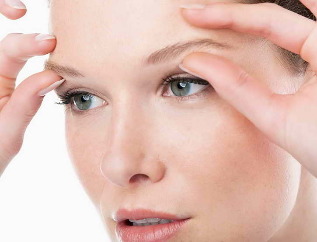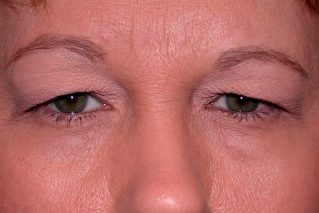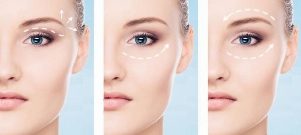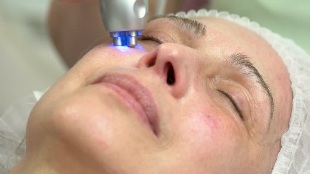
Eyelid removal is a complex of hardware, injection and manual manipulations aimed at renovating and modeling the periorbital area (the area around the eyes). This part of the face is considered an area of increased sensitivity, so non-surgical aesthetic correction of the eyelid is a difficult task even for a highly qualified specialist with extensive experience. Microsurgical cosmetology and aesthetic medicine today offer several effective methods of raising eyelids: raising radio waves, bio-fiber augmentation, contour plastic, photo rejuvenation, microcream therapy. You can choose the most appropriate technique only after a visual examination of the problem area, studying the patient's medical history, goals and ideas about what the end result should be.
Features of periorbital elevation
The eyelid region, also called the periorbital area (which is not entirely true, as the lacrimal apparatus, eyelid cleft, and conjunctival sac also belong to the periorbital space, in addition to the eyelids), is one of the most sensitive areas of the eyelids. human body with a thin layer of dermis and subcutaneous minimaledhjami. The eyelids are musculocutaneous folds, then bounded by conjunctival and cartilage tissues. They are located around the eye and perform several functions at the same time: they protect the cornea and retina from the negative effects of environmental factors (ultraviolet radiation, dust, etc. ), clean the connective tissue membrane due to the constant fluid neighborhoodLOTES, prevent drying of the eye sclera and cornea.
prevent drying of the eye sclera and cornea.
The skin in the eyelid area is several times thinner compared to other parts of the face, so it is more prone to age-related and stressful changes, which in most people become noticeable after 30 years. At this age, the process of natural dehydration of the body begins, as a result of which the epidermal cells lose moisture, and the skin loses its elasticity, becomes loose and moist. In the periorbital area in men and women over 30 years of age the first signs of aging are formed: hypodynamic folds, mimic wrinkles, wrinkles in the outer corners of the eyes ("raven legs").
An eyelid lift is a complex task that should only be performed by a highly qualified physician with excellent knowledge of topographic eye anatomy, as improper actions can not only cause new defects but also seriously damagefunction of the visual organs. The fact is that the eyelids are involved in the formation of the focus of the eye and the optical geometry of the cornea, as well as in the regulation of intraocular pressure, therefore, improperly performed plastic surgery and lifting can provoke a disorder of visual function (in some cases, irreversible).
Who needs an eyelid lift
Removal of the parabritic area has no strict medical indications (except for surgical correction, which is often used to treat pathologies that interfere with the normal functioning of the visual organs) and is usually performed at the request of the patient in order to eliminate deficiencies. aesthetically pleasing. Cosmetologists and plastic surgeons include the following defects in such disadvantages:
- strong supraorbital pair protrusion;
- excess skin in the infraorbital musculoskeletal area;
- drooping of the outer corners of the eyes;
- periorbital extensions (fatty hernias);
- periorbital edema (sacs);
- vascular pathologies leading to the appearance of traces of rosacea and dark circles under the eyes;
- hypodynamic wrinkles;
- "crow's feet" (wrinkles in the corners of the eyes);
- strongly emphasized infraorbital habits;
- "aged eyelid" (withering and laziness of the eyelid skin).
Eyelid removal also helps to make the look fresher and more open by correcting bags overloaded with skin and periorbital fat and improving the overall tone of the area. The timely use of various methods of rejuvenation of the area around the eyes helps to solve one of the main tasks of periorbital lifting - to hide age-related changes in the skin and get rid of the visual defects characteristic of biological aging ofdermis against the background of a decrease in the functional potential of epidermal cells.
The timely use of various methods of rejuvenation of the area around the eyes helps to solve one of the main tasks of periorbital lifting - to hide age-related changes in the skin and get rid of the visual defects characteristic of biological aging ofdermis against the background of a decrease in the functional potential of epidermal cells.
Important! Aging and heavy eyelids are a pretty serious aesthetic flaw that can ruin even a young and attractive face. For some, signs of skin aging in this area may appear even before the age of thirty (for example, in overweight patients or in a person with endocrine system pathology). As a rule, cosmetic products are ineffective in correcting existing problems and are only suitable for preventing premature aging, therefore the only effective method to treat this defect is periorbital elevation.
Eyelid lift surgery
An operation to lift the skin on the upper and lower eyelids is called blepharoplasty. This is a kind of radical elevation of the periorbital area, in which the effect of tightening and rejuvenation is achieved by completely removing excess skin and oily hernias in the eyelid area. Unlike non-surgical methods of eyelid lift, blepharoplasty allows not only to correct the defects of aging skin and improve the appearance of this area, but also to correct the shape and form of the eyes, as well as to get rid of pathology of the eyelids. different.
Unlike non-surgical methods of eyelid lift, blepharoplasty allows not only to correct the defects of aging skin and improve the appearance of this area, but also to correct the shape and form of the eyes, as well as to get rid of pathology of the eyelids. different.
Table. Types of periorbital radical rise
| Function type | Section area | Which pathologies can be corrected |
|---|---|---|
| Supraorbital blepharoplasty | A skin incision made along the orbital or tarsal fold of the upper eyelid. | Removal of excess skin, subcutaneous fat and muscle plastic. |
| Suborbital blepharoplasty | A transcutaneous or subciliary incision is performed. | Removal of periorbital edema, bags under the eyes, fatty hernias. |
| Circular blepharoplasty | Simultaneous eyelid surgery on both sides. | Solving common problems for all types of blepharoplasty. |
The periorbital area tightening operation is performed strictly in a hospital setting, excluding the possibility of an outpatient procedure. The patient is given general anesthesia, and the duration of the intervention is, on average, about 3 hours. A significant disadvantage of this method of eyelid lift is the postoperative period, which, although short in duration (about two weeks), is characterized by pain, the need for regular bandaging and antiseptic treatment, and significant restrictions on diet and professional activities.
Important! The advantage of surgical blepharoplasty is the ability not only to tighten the skin of the eyelids, but also to perform plastic surgery of muscle tissue, which can not be achieved using equipment and other minimally invasive methods.
Tightening of the parabital area without surgery
Surgical eyelid removal, although a very effective method of radical rejuvenation of the area around the eyes, experts advise to use it only for patients of older age group (after 40 years) with pronounced signs of aging and changes indeep skin in relation to age. Before reaching this age, while tissue hydrodynamics is within normal limits, there are many less traumatic ways to correct existing problems, and the effectiveness of most of these techniques in some cases can be compared to the outcome of surgical plastic surgery.
Injection plastics (contour)
Contour plastic surgery is probably the safest method of non-surgical tightening of the eyelid skin, which is related to mesotherapeutic procedures according to the technique. Contouring is the subcutaneous injection of special implants called fillers.
These are preparations in the form of a homogeneous and viscous suspension or gel based on ingredients that have a high degree of affinity for body tissues. These could be:
- hyaluronic acid; calcium hydroxyapatite;
- collagen (a peptide synthesized by fibroblasts and which is one of the main elements of the extracellular substance of the dermis, which provides its elasticity and ability to stretch);
- polymers based on acrylic and methacrylic acid;
- high molecular weight oxygenated silicone;
- polylactic acid;
- tripolyphosphoric acid salts, etc.
The most well-known and sought-after fillers for periorbital erection are hyaluronic acid-based preparations. These are biodegradable (absorbable) dermal implants, which not only compensate for the lack of tissue in this area, but also help eliminate wrinkles - one of the main visual signs of facial aging. The advantages of hyaluronic fillers include high hypoallergenicity and excellent results, which can be appreciated immediately after implantation. Hyaluronate bioresorption occurs within a few weeks, after which the injections should be repeated.
Biosynthetic implants based on polylactic acid and calcium hydroxyapatite retain their properties for 1-2 years.
RF-lift
Removing radio waves or radiofrequency is a non-surgical procedure for raising the area around the eyes with a high degree of effectiveness. Among the hardware techniques for minimally invasive lifting of the skin of the upper and lower eyelids, RF lifting takes the lead, as it allows not only to achieve an immediate tightening effect, but also significantly improve the skin condition in the periorbital area. .
Among the hardware techniques for minimally invasive lifting of the skin of the upper and lower eyelids, RF lifting takes the lead, as it allows not only to achieve an immediate tightening effect, but also significantly improve the skin condition in the periorbital area. .
Radio waves, penetrating the dermis to the required depth, heat the epidermal cells to the collagen density temperature, which is about 60 ° C. Under the influence of thermal energy, the dermal tissues heat up, a partial withdrawal ofcollagen framework, as a result of which the loose collagen fibers again shrink and take on their characteristic spiral shape, which is the uplifting effect.
RF augmentation is suitable for correcting all age-related problems in the area around the eyes (crow's feet, hypodynamic wrinkles, eyelid ptosis, etc. ), and the result achieved lasts up to 1-2 years. To achieve a lasting rejuvenating effect, you will need to perform about 6-10 procedures with an interval of at least 7-10 days.
Bio-fiber reinforcement (yarn lifting)
Hair removal is a procedure for the renewal of the area around the eyes, which is based on the planting of special cosmetic fibers made of different metals and synthetic materials under the skin, as a result of which a new collagen frame is formed. in the subcutaneous layers. The procedure is quite effective and allows you to deal with the problem of "aged eyelid", periorbital fat hernias, the phenomena of gravitational ptosis and other characteristic phenomena of skin aging.
There are several types of yarn for raising yarn. Fibers made of precious metals are in high demand in cosmetology. These fibers are made of platinum or gold and are created to reinforce the upper layers of the dermis. Gold fiber not only provides a noticeable uplifting effect, but also stimulates cellular metabolism, improving the supply of nutrients, oxygen and vitamins to dermal cells. Serious disadvantages of yarns made of precious metals are the high risk of detachment and the impossibility of using many cosmetic procedures, for example, photothermolysis after reinforcement.
Liquid mesothelioma is mainly used to combat small hypodynamic folds, to correct the "aged eyelid" and to soften the skin in the periorbital area. The duration of such a procedure does not exceed 20-30 minutes, but liquid fiber augmentation has many contraindications and is always accompanied by various side effects (swelling, bruising, redness). Experts believe that the most effective type of eyelid lifting is Swiss, polylactic and Korean fibers. The result after such reinforcement lasts for about 2-3 years.
Fractional photothermolysis
Fractional photothermolysis is another effective method of non-surgical skin tightening of the upper and lower eyelids. This is a type of laser refurbishment in which a fractional laser generator (for example, an erbium laser) is used to influence the problem area. The radiation generated by this device is distributed in many streams and, when it hits the skin, forms a large number of microthermal healing areas, in which the main effect occurs, so that the surrounding tissues do not heat up and are not damaged.
do not heat up and are not damaged.
A distinctive feature and at the same time the main principle of action of fractional photothermolysis is the heating of the skin to a temperature of 250-300 ° C, which experts call an evaporation procedure. Old, pathologically altered and destroyed cells under the influence of this temperature are destroyed and evaporated, while natural neocollagen is activated and the activity of fibroblasts increases, which synthesize the main components of the extracellular matrix - peptides (collagen and elastin).
The result of fractional laser resurfacing is a noticeable tightening of the skin on the eyelids, smoothing out wrinkles and creases, restoring the hydrodynamics of periorbital tissue and improving the overall condition of the skin in this area.
Pulse currents (micro currents)
- normalization of lymph flow.The effect of lymphatic drainage, which has impulsive currents on the skin, improves the movement of lymph, prevents its stagnation and helps to alleviate dark circles under the eyes;
- stimulation of metabolic processes.Activation of cellular metabolism has a positive effect on oxygen transport and nutrients and the appearance of the skin (the skin becomes smoother, acquires a healthy appearance);
- restores muscle tone.The eyelid muscles are quite weak, and the extra stimulation allows you to achieve a tightening effect.
The standard course duration is from 10 to 20 procedures, while in most cases it is necessary to repeat the procedure after a few months.

Before and after photos
Conclusion
Removing eyelids is a difficult but at the same time feasible task, for the solution of which modern aesthetic medicine offers a large number of effective methods, including low-traumatic manipulations with a low probability ofimplications. Which periorbital lift method will be most effective and safe is decided individually after talking to the patient, diagnosing the problem area, and studying medical history records.The use of surgical techniques is mainly indicated for patients with pronounced signs of aging in the area around the eyes, in which the use of gentle techniques is ineffective and apparently will not give a consistent positive result. People with the initial manifestations of the "aging century" are better to choose minimally invasive methods with a low degree of tissue trauma and a short recovery period.
























































